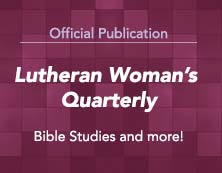Parliamentary Basics
Introduction
The parliamentary information in these guidelines is based on the current edition of Robert’s Rules of Order Newly Revised (RONR). Where a conflict occurs between the bylaws of the Lutheran Women’s Missionary League and RONR, the bylaws take precedence.
Did you know that… the following principles of parliamentary procedure were introduced and agreed upon many centuries ago?
1581 One subject at a time
1592 Opposite views expressed alternately in debate
1604 The chair always calls for the negative vote
1604 No personal attacks in debate
1610 Debate is confined to merits of the questions
1640 Division of the Question
Parliamentary Basics for Everyone
Meetings of the Lutheran Women’s Missionary League are marked by good order, guided by God’s Word, and upheld in prayer.
The parliamentary hints contained in these guidelines are intended to help everyone understand how group decisions are made. Rules of procedure were developed over several centuries. With these rules in place, organizations can function more efficiently and fairly.
Ideally each member will participate – proposing motions, making amendments, debating and voting. If members do this, the group will avoid unwise decisions, and good ideas will be perfected for action.
Basic Agenda
It is a good idea for the president to prepare a basic agenda in advance of the meeting. This written outline or order of business helps the president to take up each item in a logical sequence. Then as the meeting progresses, she can note what action was taken. In preparing the agenda she will review the minutes of the previous meeting with the secretary and consult with other officers who intend to introduce new business.
Presiding officers often expand the basic agenda into a script agenda, which includes everything the chair knows she will say during the meeting from “The meeting will please come to order” to “The meeting is adjourned” (see below).
It will be important for the president to check on arrangements for the meeting room and arrive early enough to begin the meeting on time. It is also her duty to determine whether a quorum is present.
The quorum is the minimum number of voting members who must be present in order to transact business legally. A group’s bylaws should establish the quorum. If not, the quorum is a majority of the membership.
1. Call to Order
(One tap of the gavel)
“The meeting will please come to order.”
At this time the president welcomes guests and introduces them to the assembly.
2. Opening Devotion and/or Bible Study
3. Roll Call (optional)
4. Reading and Approval of Minutes
“The secretary will read the minutes of the last (or September, etc.) meeting.” (Secretary stands and reads)
“Are there any corrections to the minutes? (Pause) If not, they stand approved as read.”
If there are corrections, they are usually accepted by general consent (everyone in agreement, but no formal vote taken), and the president then declares, “The minutes stand approved as corrected.”
The reading of the minutes may be dispensed with at this time, but they must be read and approved at some point. The minutes may be approved by a pre-appointed committee, or they may be printed and distributed to the membership prior to the meeting, where they would be considered for approval.
At this point the president may ask the secretary to read any correspondence. The reading of the correspondence which requires assembly action may be delayed until a more appropriate time on the agenda.
5. Financial Statement
“We will now have the treasurer’s report.” OR “The treasurer will give the financial statement.” (Treasurer stands and reads. The treasurer need only state the beginning balance, the receipts, the disbursements, and the ending balance.)
“Are there any questions for the treasurer? (Pause) The report will be filed.”
Her report is not “filed for financial review.” It should not be “accepted,” “adopted,” or “approved.” No action is taken on the treasurer’s report. At the end of the fiscal year, the treasurer’s books are presented for financial review, and that report is adopted. This releases the treasurer from further responsibility.
6. Reports of Other Officers, Boards, and Standing Committees
The officers, boards, and standing committee chairmen report in the order they are listed in the bylaws, the president reporting first. Often the group bylaws will prescribe whether reports are required at each meeting or annually.
7. Report of Special Committees
Special Committees report in the order that they were appointed.
8.Special Orders
Matters that the bylaws require to be considered at a particular meeting, such as election of officers, may be addressed here on the agenda.
9. Unfinished Business and General Orders
Items considered in this category are drawn from the minutes and introduced by the president.
Unfinished business is business brought over from a previous meeting because adjournment occurred before the agenda was completed. General orders are items that were postponed to the present meeting for action.
10. New Business
“Is there any new business?” The president introduces new items of business requiring action. Members may also make motions as long as no other question is pending. Out of courtesy, a member should notify the president if she intends to present an item new business. The president may ask, “Is there any further new business?”
Sometimes the question arises as to whether an item is new business or unfinished business. If a subject has been mentioned at the last meeting and there is an informal understanding that it will be discussed at the next meeting, it should be brought to the floor here as new business.
11. Announcements (placed here or after the program)
The president reads from a prepared list and then asks, “Are there further announcements?”
12. Program
The program is usually presented before the meeting is adjourned, although the custom in some groups is to have the program before the business portion of the meeting. The president says, “The program chairman will present the program (speaker).” At its conclusion, the program chairman states, “Madam Chairman that concludes our program.” The president thanks the chairman and the speaker. She then guides the assembly to the next business in order.
13. Adjournment
There may be a formal motion to adjourn but it is not required. The president may ask, “Is there any further business? (Pause) Since there is no further business, the meeting is adjourned.” (single tap of the gavel)
14. Closing Prayer/Hymn
I am present with you in spirit and delight to see how orderly you are and how firm your faith in Christ is (Colossians 2:5b NIV).
Some Parliamentary Pointers
Using parliamentary procedures consistently will result in the following:
Courtesy to all
One item considered at a time
The majority will rule
The minority will be heard
Absent member’s rights will be protected
Partiality to no one, fairness to all
It is common meeting practice that the majority (more than half) of the voters make the decisions. However, there are times when the minority will prevail. Whenever motions are made that will effect the rights of individual members, parliamentary procedure requires that two-thirds (2/3) of the voting members must agree. This principle applies, for example, when amending bylaws, limiting debate on a motion, and suspending the rules. When a minority of more than one-third (1/3) of the voters objects to the motion, it is defeated.
Bylaws can be defined simply as a written agreement among an organization’s members describing the structure and rules according to which they will take action. Organizations desiring to be consistent in practice, efficient in action, and clear in defining responsibilities of officers and members will draw up a set of bylaws. Bylaws are a safeguard against hasty, inconsistent, and unwise decisions.
They should be concise, to the point, and no more detailed or restrictive than necessary. They are adopted initially by a majority vote, but thereafter can be amended only by a two-thirds (2/3) vote with prior notice.
Steps in Making a Motion
- A member addresses the chair (the presiding officer).
- The chair recognizes the member.
- The member states her motion (proposal for the group to take action).
- Another member seconds the motion.
- The chair repeats the motion and opens the question for debate.
- The members debate.
- The chair states the question and takes the vote (positive and negative).
- The chair announces the results and the action that will or will not be taken.
More about Motions
The main motion introduces a subject to the assembly. There can be only one main motion under consideration at one time.
A secondary motion takes precedence (pre-see-dense) over a main motion. That means that it can be moved and voted on even though a main motion is already on the floor. There are twelve secondary motions (seven subsidiary motions and five privileged motions) which over the years have come to be used in particular order of rank. (Other secondary motions, called incidental motions, have no rank among themselves.) This rule of precedence (one motion yielding to another above it) is illustrated later on in these guidelines.
A subsidiary motion is used to help the assembly mold or recast the main motion into a more precise statement of the group’s intentions. A motion to postpone indefinitely is an attempt to kill a bad motion. A motion to amend is a move to change one detail of the main motion. A motion to commit (refer) says that the group needs more time to reconstruct the motion or more information to make a decision and wants a smaller group to be given the responsibility.
A privileged motion is used to interrupt debate in order to consider a matter of urgent importance, such as improving room ventilation, quieting a noisy disturbance, asking for a return to the order of business prescribed in the agenda, and other requests. Privileged motions do not relate to the pending business and can usually be taken care of in an informal way by the chairman.
Incidental motions do not relate to the subject of the main motion but deal with matters of procedure, and most are not debatable. They require attention before business can proceed or before a pending question can be put to a vote. Examples: the motion to consider seriatim (paragraph by paragraph, or section by section); to ask for information; to close nominations; to withdraw a motion; to suspend the rules.
If a motion is made and adopted which conflicts with the bylaws, it is null and void.
It is not wise to make negative motions. Example: “I move that we do not contribute to this fund.” Negative motions cause confusion for members. Do I vote yes or no? Better to word the motion this way: “I move that we oppose” or “declare our opposition to” the issue. It is also not wise to move that the group reaffirm a position previously taken. If the motion to reaffirm fails, it would create an ambiguous situation.
Avoid stating “I so move.” Someone may not have caught the informal comment made by another member, nor something just spoken by the chair. It is advisable to state the complete motion using the words, “I move that…” or “I move to….”
Before a motion is stated by the chairman, it may be withdrawn by the maker without a vote. But after the chair states the motion it can be withdrawn only by a majority vote of the assembly or by general consent.
More about Amendments
An amendment must be germane to the subject of the main motion. It can propose a change, thus giving the main motion an opposite meaning, but the proposed amendment must have a close connection to the subject.
There are various ways to change (amend) a motion:
- To insert (within the motion) or add (at the beginning or end of the motion) OR
- To strike out OR
- To strike out and insert (a combination of the first two ways).
The assembly may offer any number of amendments, but only two may be pending at any time. These two amendments are referred to as the primary and secondary amendments. The secondary amendment is a motion to amend the primary amendment. When debate has stopped, a vote is made on the secondary amendment, and then the primary amendment. If there are no more subsidiary motions, the main motion (as amended) is brought to a vote.
Debate
The maker of a motion is usually given the first opportunity to speak. She may not speak against the question, but she may vote against it.
Debate must be confined to the merits of the pending motion. All discussion is addressed to the chairman, not directed toward another member.
When many members wish to speak to the motion, the chair will try to alternate comments between those who favor the motion and those who oppose it.
The chair is careful to see that all have a chance to speak. Therefore, as a general rule, no one can speak more than twice on the same question, unless the assembly grants permission.
To preserve her impartiality, a president does not enter into debate.
To close debate, a member may move the previous question. This means that the member would like the chair to call immediately for the vote on the questions presently being debated. The motion to order the previous question (to close debate) must be seconded, is not debatable, and requires a two-thirds (2/3) vote. If this motion passes, another vote is immediately taken on the pending question. However, if the motion to close debate fails, discussion may continue as before.
Voting
Aye and no are voice votes and are the votes most often used in deliberative assemblies. In LWML a show of hands is frequently used also. The chair always calls for the negative vote, even if the vote seems to be unanimous in the affirmative.
The chair may call for a rising vote, or a member may demand a rising vote by calling out, “Division!” The chair may call for a rising vote to be counted, or a member may move that a rising vote be counted (requiring a second and a majority vote). The chair may then ask the secretary or the appointed tellers to count the vote, or the standing members may count off one by one.
A tie vote is a lost vote. The chair may (but is not obligated to) vote to break the tie, causing the motion to be adopted if voting in the affirmative. She may vote to create a tie, causing the motion to be lost.
The presiding officer may use the procedure of general consent to save time when no difference of opinion appears to exist. To ask for a motion to approve the minutes is not necessary. (See Reading and Approval of Minutes)
In a plurality vote the winning candidate is the one who receives the largest number of votes when three or more choices are available. But to decide an election of one person by plurality vote is not in the best interest of a group. A plurality vote is used in an election where there are several names or items to be chosen, such as in electing the nominating committee and in selection of mission grant proposals.
It is probably not fair to allow absentee voting (when votes of those present and those votes sent in ahead are combined and counted together). It is not valid to allow proxy voting (when a person present at the meeting casts a vote in place of an absent person), unless authorized in the bylaws. Free discussion and debate on a motion is an essential part of group decision making and, if there are a large number of proxies and absentee ballots, debate on the issue at the meeting is practically useless.
A majority vote is based on the number of votes cast, not on the number of eligible voters nor on the number present nor on the total membership, unless stated in the bylaws. Thus, a person who abstains gives up her right to affect the outcome of the vote.
A member who desires a secret vote may move that a vote by ballot be taken. This motion requires a second and a majority vote for adoption.
It is out of order after balloting to move that the secretary cast a unanimous ballot. Unless the result of the balloting was unanimous, the assembly is taking away a member’s dissenting vote or is asking her to reveal her vote by opposing the motion.
There are exceptions to some of the above. To learn more, consult the RONR text and tinted pages.
Motions Ranked in Order of Precedence
[key: Sec= Requires a second; Am=Is amendable; Deb=Is debatable; M=Majority vote; 2/3=2/3 vote; Ch=The chair rules; I=May interrupt]
Privileged motions (highest)
|
13 |
Fix Time to Which to Adjourn |
Sec |
|
Am |
M |
|
|
12 |
Adjourn |
Sec |
|
Am |
M |
|
|
11 |
Recess |
Sec |
|
Am |
M |
|
|
10 |
Raise a Question of Privilege |
|
|
|
Ch |
I |
|
9 |
Call for Orders of the Day |
|
|
|
Ch |
I |
Subsidiary Motions
|
8 |
Lay on the Table |
Sec |
|
|
M |
|
|
7 |
Previous Question |
Sec |
|
|
2/3 |
|
|
6 |
Limit/Extend Limits of Debate |
Sec |
|
Am |
2/3 |
|
|
5 |
Postpone to a Certain Time |
Sec |
Deb |
Am |
M |
|
|
4 |
Commit (or Refer) |
Sec |
Deb |
Am |
M |
|
|
3 |
Amend |
Sec |
Deb |
Am |
M |
|
|
2 |
Postpone Indefinitely |
Sec |
Deb |
Am |
M |
|
|
1 |
Main Motion (Lowest) |
Sec |
Deb |
Am |
M |
|
When any one of the above secondary motions is brought to the floor, it takes precedence over any motion lower on the list. Accordingly, any motion above it has higher precedence and must be disposed of before any motion below it is voted on.
Some Incidental Motions (non-ranking)
|
Appeal |
Sec |
Deb |
|
M |
I |
|
Close Nominations |
Sec |
|
Am |
2/3 |
|
|
Consider Seriatim |
Sec |
|
Am |
M |
|
|
Division of the Assembly |
|
|
|
|
I |
|
Division of a Question |
Sec |
|
Am |
M |
|
|
Point of Information |
|
|
|
|
I |
|
Suspend the Rules |
Sec |
|
|
2/3 |
|
(revised 7/19)








